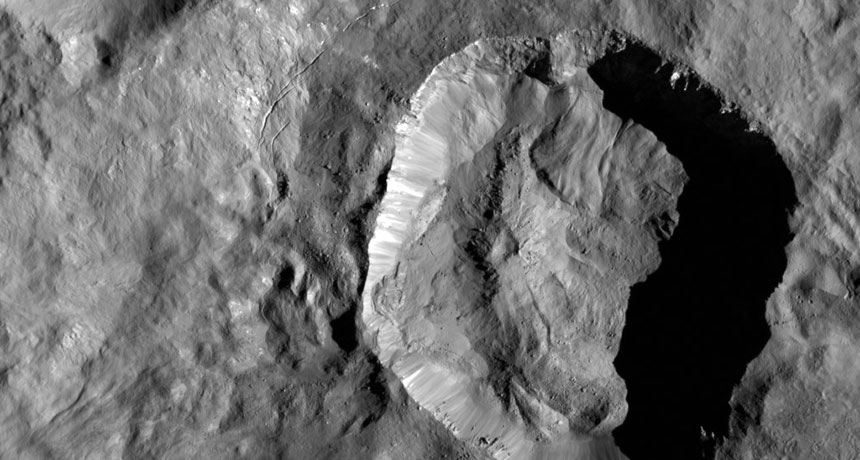Dwarf planet Ceres may store underground brine that still gushes up today

Ceres may be regularly coughing up briny water or slush onto its surface.
The discovery of waterlogged minerals and a growing ice wall suggests that the dwarf planet could harbor underground liquid water or slushy brine, which has escaped through cracks and craters in the recent past and may still be seeping out today. The findings, reported in two papers published online March 14 in Science Advances, add to a growing realization that Ceres is geologically active — and may point to new signs of the dwarf planet’s potential to host the ingredients for life.
“We thought of Ceres as a dead body like our moon,” says Andrea Raponi, a coauthor of both studies and a planetary scientist at the Institute for Space Astrophysics and Planetology in Rome. The growing body of evidence “means that Ceres is geologically alive, active, in our days.”
Since 2015, NASA’s Dawn spacecraft has orbited Ceres, the largest object in the asteroid belt between the orbits of Mars and Jupiter. The mission has previously revealed Ceres has water ice in shadowed regions of its craters and a few meters below the surface (SN: 1/21/17, p. 8). The dwarf planet also has what look like cryovolcanoes, which spew slushy water instead of magma.
Now, scientists have used data from Dawn to make the first global map of surface carbonate minerals, which form in the presence of liquid water. In one of the new papers, the team reports finding hydrated sodium carbonate — versions of the minerals that still have water molecules attached.
Because the dwarf planet has no atmosphere, that water can’t hang around more than a few million years, says study coauthor Filippo Giacomo Carrozzo, also a planetary scientist at the Institute for Space Astrophysics and Planetology in Rome. With no protective shield, cosmic radiation breaks the water’s bonds to other molecules, and the water evaporates relatively quickly into space. The presence of so much hydrated sodium carbonate on the surface means something must be replenishing it.
Previous research had found other hydrated minerals called phyllosilicates on Ceres’ surface (SN: 10/1/16, p. 14). Finding more lingering water molecules further supports the idea that “the process of hydration is ongoing today,” Carrozzo says.
The hydrated sodium carbonates are particularly concentrated near craters and domes, suggesting that briny water or slush wells up from the subsurface in an ice volcano. Or impact craters may excavate rock and soil, exposing the brine, the researchers say.
Both ideas are “viable mechanisms,” says Lucy McFadden of NASA’s Goddard Space Flight Center in Greenbelt, Md., who is a member of the Dawn team but was not involved in the new papers. “It’s all pretty exciting stuff.”
In the second study, Raponi, Carrozzo and colleagues report that a wall of water ice in a crater called Juling grew from about 3.6 square kilometers to 5.5 square kilometers from April to October 2016. “We see, under our eyes, a change in the cover of water ice in a period of six months,” Raponi says. The change took place as the dwarf planet’s 4.6-year orbit was taking Ceres closer to the sun, the equivalent of moving from winter to spring, she says.
Some of the ice could have been buried beneath dirt, which sloughed off as the ice beneath it warmed and revealed fresh ice as the seasons changed, the team argues. Or freshwater or brine could have welled up from below and froze in the shadowed crater wall. Features on the crater floor seem to support this upwelling idea, Raponi says.
If water is upwelling from below, it’s hard to explain how it stays fluid beneath the surface, Raponi admits. Icy moons with subsurface oceans, like Enceladus and Europa, get a constant influx of heat from the gravity of the giant planets they orbit, Saturn and Jupiter. But Ceres has no such heat source.
But if Ceres does have a stable layer of subsurface liquid, that could increase its potential to be habitable, Raponi says. Previous studies have found organic molecules on Ceres’ surface, too (SN: 3/18/17, p. 8). “If we have all the ingredients of life in a geologically active body, that can be very interesting,” Raponi says.


